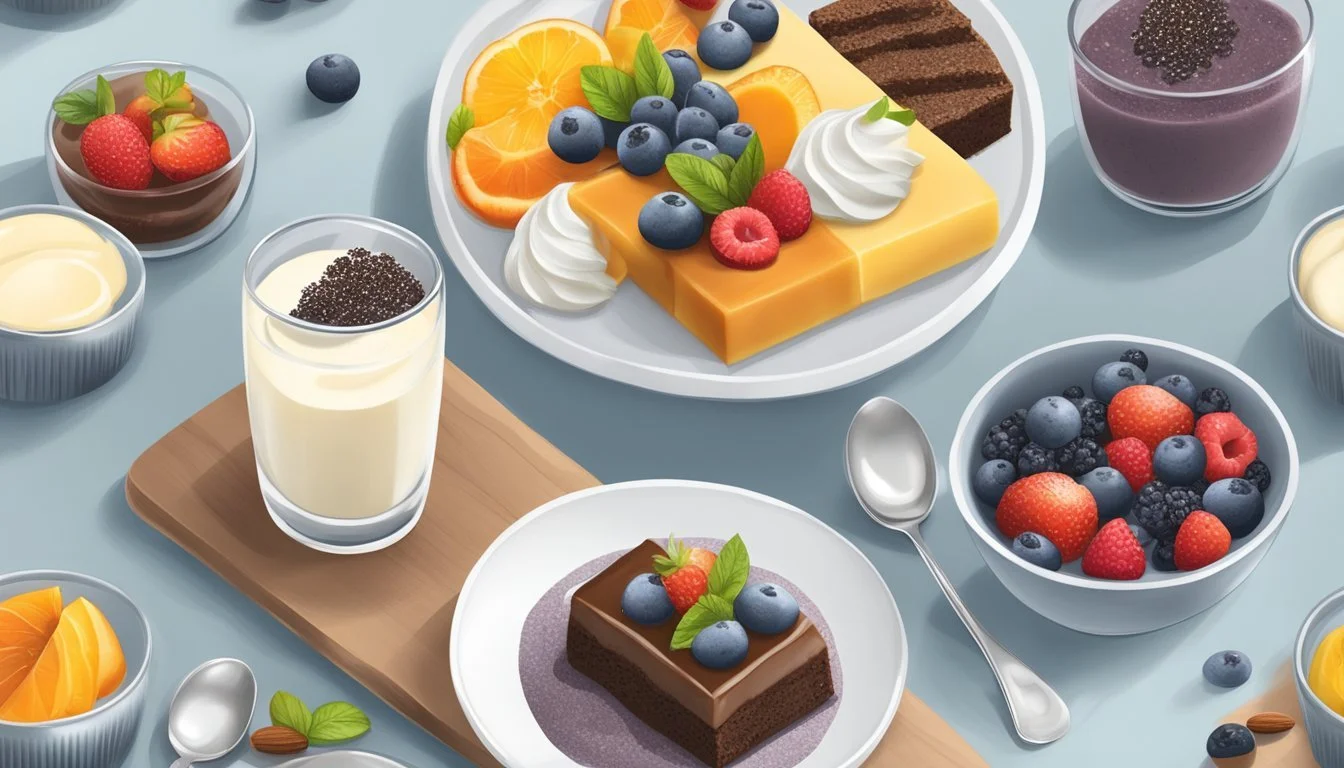What Are Some Lactose-Free Dessert Recipes
Indulge Without Dairy
For those with lactose intolerance, finding dessert options that don't cause discomfort can be a bit of a challenge. Lactose intolerance affects individuals by causing digestive discomfort when they consume dairy products, which are common in many traditional desserts. However, the growing demand for inclusive diet options has led to an array of delicious dairy-free desserts that everyone can enjoy, not just those avoiding lactose for health reasons. These treats often incorporate ingredients like coconut milk, almond milk, and other plant-based substitutes that provide the creamy texture and rich flavor that dairy typically contributes to desserts.
The variety of lactose-free dessert recipes available ensures that there's no need to miss out on indulgence. From frozen treats like ice cream made with coconut milk to baked goods that substitute traditional dairy ingredients with vegan alternatives, these recipes cater to all tastes. Special occasions and everyday cravings alike can be satisfied with desserts that include spiced rum and pear cakes, macaroons, or zucchini bread, which forego dairy without compromising taste or texture.
Bakers and cooks have become increasingly creative in adapting dessert recipes to be dairy-free, proving that lactose intolerance needn't be a barrier to enjoying a sweet treat. By swapping out certain ingredients, classics are transformed into inclusive creations. Whether one chooses a quick and simple recipe for a busy weeknight or a more elaborate confection for a festive celebration, there are plenty of lactose-free options to delight the palate.
Understanding Dairy Substitutes
Replacing dairy in desserts requires understanding the roles different ingredients play and selecting suitable alternatives that achieve a similar taste and texture.
Vegan Butter and Oils
In baking and dessert recipes, butter adds richness and flavor. Vegan butter is an excellent dairy-free substitute that emulates the taste and consistency of traditional butter. It's made from plant-based oils like soybean, coconut, or olive oil and often contains a mix of fats to replicate butter's characteristics.
Olive oil is a healthier fat option that can impart a subtle fruity flavor, ideal for certain cakes and cookies.
Coconut oil, with its creamy and slightly tropical taste, offers a rich texture, making it a good choice for frostings and confections.
Milk Alternatives
Dairy milk can be easily substituted with various plant-based milks in dessert recipes. Each alternative offers a unique flavor profile and nutritional content:
Coconut milk: Creamy and rich, it's a favorite for making ice creams or creamy desserts.
Almond milk: With a lighter texture and nutty taste, it is suited for dairy-free custards or as a liquid ingredient in baking.
Cashew milk: Homemade from soaked cashews, it creates a neutral and creamy base for desserts such as cheesecake.
Egg Replacements
Eggs are used for binding, leavening, or adding moisture. In dairy-free baking, finding the right egg-free substitute can be critical and requires considering the egg's purpose in the recipe.
Flax seeds: When ground and mixed with water, they form a gelatinous mixture that can mimic the binding properties of eggs.
Cornstarch: Mixed with water, it can help thicken custards or puddings in place of eggs.
Using these substitutes, home chefs and professionals alike can create dairy-free desserts that are both delicious and accommodating to dietary restrictions.
Recipes for Lactose-Free Desserts
Exploring lactose-free desserts unlocks a world of sweet possibilities for those avoiding dairy. These recipes ensure that dietary restrictions don't equate to a compromise on taste and texture.
Cakes and Breads
For cake enthusiasts, a moist Carrot Cake made with almond milk and robust spices can satisfy that classic craving. Olive oil cake offers a rich, fruity alternative, perfectly paired with fresh citrus. Those seeking comfort in a loaf will appreciate Zucchini Bread, where grated zucchini melds with cinnamon and nutmeg for a moist, flavorful crumb. A dairy-free Blueberry Coffee Cake provides a fruit-forward treat, while Spiced Applesauce Cake favors a dense, moist texture punctuated by warm spices.
Cookies and Bars
Turning to handheld delights, Sugar Cookies use dairy-free margarine and almond milk for a tender, sweet bite. Indulgent Peanut Butter or Almond Butter cookies cater to nut lovers, while Macadamia Nuts elevate the classic cookie with their rich, buttery profile. For fruity chew, Berry Crumb Bars with raspberry filling and a rolled oats crumble offer a satisfying crunch and tartness. Dairy-free margarine keeps these bars crumbly and cohesive without dairy.
Pies and Tarts
In the realm of pies and tarts, a classic Pumpkin Pie with a dairy-free twist fills that holiday niche, using coconut milk for the creamy texture. Banana Cream Pie can be reinvented without the lactose by employing almond milk and dairy-free whipped topping. Meanwhile, a tangy Lemon Curd Tart highlights citrus flavors using a silken tofu base. For those craving the zestier side of life, Lime Bars on a crumbly, dairy-free crust can provide a sharp, refreshing dessert option.
No-Bake Treats
The joy of no-bake treats comes with their simplicity and speed. Coconut Macaroons are a chewy, sweet delight that can be prepared without any dairy. A creamy Vegan Chocolate Pudding uses avocado as a base to achieve its smooth consistency. For an easy-to-make indulgence, 5-Ingredient White Chocolate Truffles can be put together using dairy-free white chocolate and coconut milk. These no-bake desserts demonstrate that convenience and lactose-free indulgence can go hand-in-hand.
Creating Creamy Dairy-Free Desserts
Creating creamy textures without dairy is achievable with the right ingredients and methods. Substitutes such as coconut cream and almonds pave the way for decadent vegan desserts that cater to those with lactose intolerance or dairy allergies while still satisfying the craving for something rich and satisfying.
Puddings and Cream Pies
To achieve the velvety consistency of traditional chocolate pudding or banana cream pie, one can swap out dairy with alternatives like coconut cream or almond milk. Vegan chocolate pudding, for instance, can be made by thickening almond milk with cornstarch and cocoa powder. A delightful banana cream pie becomes lactose-free by using a creamy blend of ripe bananas and coconut cream as its filling, set atop a crust made from dates and nuts.
Rich and Indulgent Brownies
Dairy-free brownies and vegan brownies need not lack in richness. Substitutes like avocado or pureed pumpkin can stand in for butter, while almond meal provides structure and moistness. For a twist on classic brownies, pumpkin blondies offer a dense, moist texture with autumnal spices and the added benefit of being dairy-free.
Ingredients for moist dairy-free brownies:
Avocado or pureed pumpkin
Almond meal or flour
Vegan chocolate chips
Ice Creams and Sorbets
Without an ice cream maker, one can still prepare delicious coconut ice cream by blending frozen coconut cream with sweeteners and flavorings, then freezing the mixture until firm. Sorbets are naturally dairy-free, relying on fruit puree and sugar, churned in an ice cream maker to create a refreshing and smooth frozen treat.
Simple sorbet recipe:
2 cups fruit puree
1/2 cup sugar (adjust to taste)
1 tablespoon lemon juice
Cheesecakes and Frostings
Vegan cheesecake utilizes soaked cashews or dairy-free cream cheese alternatives to mirror the creamy texture of a classic cheesecake. These versions can be just as rich and satisfying as their dairy counterparts. For frosting, a mixture of vegan cream cheese and plant-based butter can be whipped until light and fluffy, perfect for topping carrot cake or cupcakes.
Vegan cream cheese frosting recipe:
1 cup vegan cream cheese
1/2 cup plant-based butter
2-3 cups powdered sugar
1 teaspoon vanilla extract
Alternative Sweeteners and Flavors
When crafting lactose-free desserts, one has the versatility of employing a variety of sweeteners and flavors that extend beyond traditional sugar. These include plant-based sweeteners, nut and seed butters for richness, and fruit and spice blends for depth of flavor.
Sweeteners Beyond Sugar
Beyond white sugar, there are multiple sweetening alternatives that cater to a lactose-free and health-conscious diet:
Agave: A plant-based syrup that offers a lower glycemic index than sugar.
Dates: Provide a natural sweetness and can be pureed to sweeten desserts.
Honey (for those not strictly vegan): Adds a unique floral taste.
Maple Syrup: Imparts a warm, woody sweetness that pairs well with other flavors.
Stevia: A no-calorie sweetener derived from the leaves of the Stevia plant.
Nut and Seed Butters
Nut and seed butters not only introduce a creamy texture to desserts but also impart their own subtle sweetness:
Almond butter: Offers a mild, nutty flavor and works well in items like blueberry chia pudding.
Peanut butter: A classic choice that provides a rich taste and pairs delightfully with chocolate.
Tahini: Made from sesame seeds, tahini adds a slight bitterness that can complement sweeter ingredients.
Fruit and Spice Infusions
Fruits and spices can infuse desserts with vibrant flavors, reducing the need for added sugars:
Vanilla: Its aromatic quality enhances the natural sweetness in desserts.
Cinnamon: A warm spice that not only adds a sweet-scented warmth but may also help balance blood sugar levels.
Berries: A mix of berries can offer a natural tartness and sweetness; perfect for recipes like chocolate covered strawberries.
Special Considerations in Dairy-Free Baking
Creating delectable dairy-free desserts requires attention to detail, with alternatives in flours and fats playing pivotal roles. The richness of chocolate and the texture of frozen treats can be meticulously crafted by using appropriate dairy-free ingredients.
Gluten-Free Baking
Those baking dairy-free often pair this need with gluten-free requirements. Flour substitutes like gluten-free all-purpose flour or almond flour significantly alter the texture and taste of the final product. For example, dairy-free cupcakes made with gluten-free flour may require xanthan gum to mimic the binding quality of gluten. Here's a basic conversion guide:
Traditional Flour Gluten-Free Substitute Notes 1 cup wheat flour 1 cup gluten-free blend May need to adjust liquid ratios N/A 1/4 tsp xanthan gum per cup of flour If not included in the blend
Bakers must ensure that cross-contamination is avoided to ensure true gluten-free outcomes.
Decadent Chocolate Creations
Creating chocolate treats without dairy, such as chocolate cakes or vegan brownies, involves using non-dairy chocolate varieties. Vegan chocolate often utilizes cocoa butter and omits milk solids, while white chocolate can be challenging due to its reliance on milk products for its signature creaminess. Here is a tip for chocolate selection:
Choose high-quality vegan chocolate: This ensures the rich flavor is still present in the dessert without any dairy components.
Frozen Delights
Frozen desserts come in many forms, from sorbet and granita to more creamy creations like fudge and dairy-free ice creams. Substituting canned coconut milk can satisfy that sweet tooth craving for creaminess in a frozen dessert. For instance:
Sorbet is naturally dairy-free and focuses on fruit purity.
A granita offers a crunchy, icy texture and is equally refreshing.
Use full-fat coconut milk for a creamy texture in fudge or ice cream desserts.
It is crucial to understand the freezing point of the substitutes used, as some may require additional ingredients to prevent over-hardening.
Nutritional Information and Benefits
Choosing dairy-free dessert recipes can provide nutritional benefits while catering to lactose intolerance or dairy allergies. They can also be a part of a well-balanced diet.
Health Benefits of Dairy-Free
Dairy-free desserts often incorporate a variety of alternative ingredients that bring their own set of health advantages. For individuals with lactose intolerance or dairy allergies, these desserts eliminate the discomfort and health issues associated with dairy consumption. Plant-based milks and butters, for instance, can offer nutrients like omega-3 fatty acids, especially when derived from sources like almonds or flaxseeds. These desserts also often include fruits, providing vital vitamins and antioxidants without the cholesterol found in dairy products.
Caloric and Macronutrient Profiles
The caloric and macronutrient profile of dairy-free desserts can vary widely depending on the ingredients used. A comparison of typical ingredients may look like:
Ingredient Calories per 100g Carbohydrates Proteins Fats Almond Milk 17 0.6g 0.7g 1.5g Coconut Milk 230 6g 2.3g 24g Soy Milk 54 6.3g 3.3g 1.8g Maple Syrup 260 67g 0g 0.1g Dark Chocolate 598 45.9g 7.79g 42.63g Fresh Strawberries 32 7.68g 0.67g 0.3g
Given this information, one can design dairy-free desserts that are lower in calories and fats compared to traditional desserts, or opt for richer, more indulgent versions using ingredients like coconut milk or dark chocolate. Importantly, they must balance taste with nutritional content to fit into their dietary needs.





